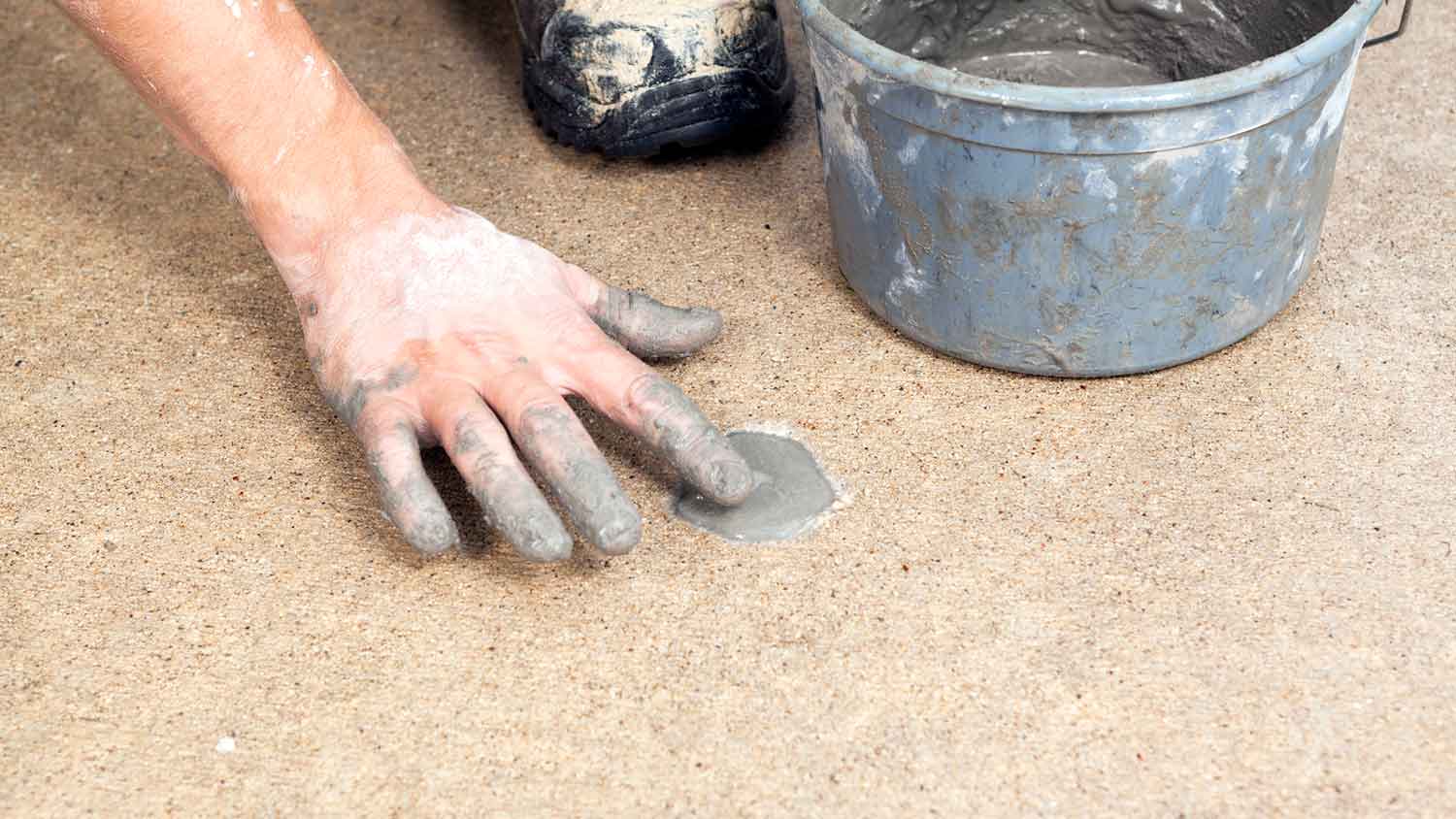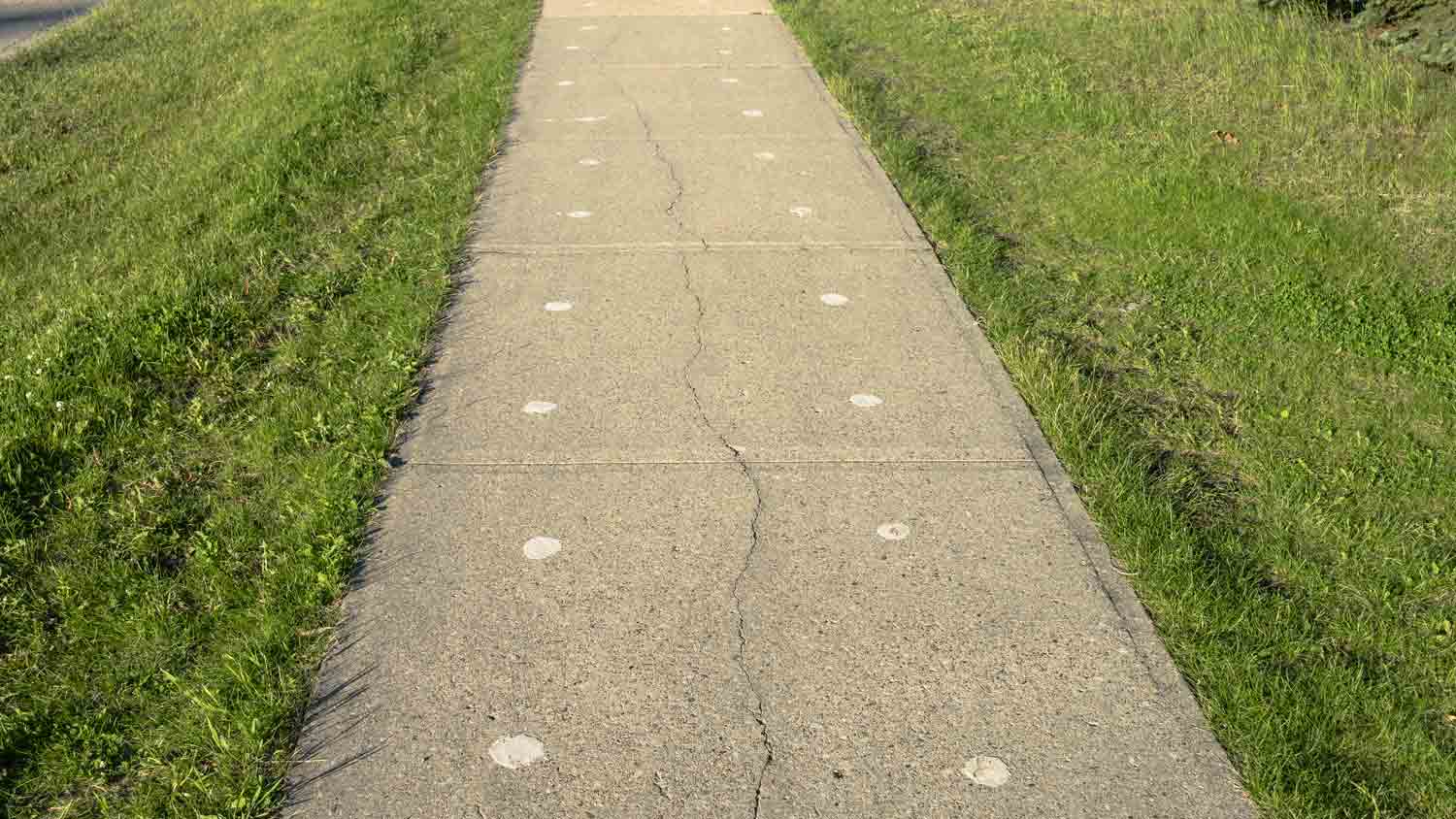How Much Does Polyurethane Concrete Lifting Cost? [2025 Data]
Polyjacking costs an average of , and most homeowners pay between and . Get a professional estimate to see how project size and scope affect your total.


Polyurethane concrete lifting costs an average of to lift a 300-square-foot section of concrete back into place. You can expect to pay between $5 and $25 per square foot of concrete you need to be lifted. You could pay as little as to lift a small concrete slab that’s fully exposed, like a sidewalk, back to its original position, or as much as to lift a structural slab that’s larger and more challenging to access.
Polyjacking Cost Factors
There are a few key factors to consider that can affect the price you’ll pay for polyurethane concrete lifting, also called polyjacking. Be sure to consider all of the following to get an accurate estimate, or reach out to a pro for a total concrete leveling cost.
Size of the Sunken Area
Polyjacking costs an average of $15 per square foot, but prices range from $5 to $25 per square foot. Most contractors will charge by the square foot, so the size of the slab you need to be lifted will play the biggest role in your total cost.
| Slab Size (Sq. Ft.) | Average Cost | Cost Range |
|---|---|---|
| 10 | $150 | $100–$250 |
| 25 | $375 | $125–$625 |
| 50 | $750 | $250–$1,250 |
| 100 | $1,500 | $500–$2,500 |
| 250 | $3,750 | $1,250–$6,250 |
| 500 | $7,500 | $2,500–$12,500 |
Location and Accessibility
The location and size of the slab you need to be lifted will account for most of the total cost. Slabs that are exposed and easily accessible, like sidewalk squares, concrete patios, and pool decks, will be the most affordable to lift. Your contractor can not only spend less time assessing the area and carrying out the work, but the lifting process itself is less technical because there’s nothing structural above it.
Slabs that act as the foundation or part of the foundation of your home are more complicated to access, and the risk of resulting structural damage is high, so costs will climb accordingly. Lifting a small 100-square-foot section of concrete that provides direct support for your home can cost more than lifting a 500-square-foot section of an easily accessible concrete patio.
| Concrete Location | Cost per Sq. Ft. |
|---|---|
| Basement floor | $20 |
| Patio | $10 |
| Pool deck | $10 |
| Sidewalk | $5 |
| Slab foundation | $25 |
Labor
Labor accounts for between 70% and 80% of the cost of polyurethane concrete lifting. This includes an assessment of the area and how the foam will react to the surrounding soil and concrete, drilling the holes through the slab, and pumping the polyurethane foam underneath. The average labor cost to lift a 300-square-foot section of concrete is between $2,100 and $2,400.
Finishing

Polyjacking requires drilling large holes in your concrete to gain access to the underside of the slab, so you’ll need your professional to refinish the area to fill in the holes, remove trip hazards, and make the slab look complete again.
For sidewalks, patios, and pool decks, this can be as simple as pumping a small amount of concrete into the hole and leveling and finishing the surface to match the rest of the slab. If you’re polyjacking a slab foundation or a slab that sits under a finished basement floor, your project costs could go up to cover the added expense of restoring the flooring. Professionals may include this line item in your total, or they could add $100 to $400 to the total to reinstall hardwood, vinyl planks, or tile over the slab after the lifting is done.
Polyjacking Ongoing Costs
Polyurethane concrete lifting is a more permanent solution to sinking concrete than mudjacking or sandjacking, but there are some ongoing costs you could incur, depending on your situation.
Surface Repairs
Polyjacking creates a new base of support under your concrete slab, and some settling can occur after the lifting process. You could find that the slab develops some hairline cracks in response to the movement, so you might want to budget for minor surface repairs and crack sealing within the first few months of the initial repair. Sealing surface cracks in a concrete slab costs between $75 and $200, and you could spend as little as $15 by DIYing the work.
Inspections
If your professional is lifting a structural slab, like a portion of your home foundation, you should schedule routine foundation inspections going forward to confirm that there isn’t additional movement or resulting structural instability. A foundation inspection costs $600 on average. You should schedule one a year after the repair and then once every two to three years after that to catch developing issues.
DIY Polyurethane Concrete Lifting vs. Hiring a Pro
Lifting concrete back into its original position is challenging work that requires training and experience to do properly. Especially with expanding polyurethane foam, injecting the wrong amount of material under your slab could leave you with additional structural damage and uneven concrete surfaces, so you should never attempt to do the work yourself.
Even if you wanted to, the equipment to pump polyurethane foam isn’t normally available for DIYers to rent, so you’ll need to defer to a pro. Contact a concrete mudjacking company near you to ask about polyurethane concrete lifting and get the best results possible.
Cost of Common Polyjacking Add-Ons
Polyurethane concrete lifting is rarely a standalone service because you still have an underlying issue that needs a resolution. You should hire a professional to determine what your underlying problem is and then budget for the appropriate solution. Below are some costs related to home improvement projects to consider.
Cost to install a gutter system: $625–$1,700
Cost to repair gutters: $200–$650
Cost to fill in a sinkhole: $10,000–$100,000
Cost to install a French drain: $500–$18,000
How to Save Money on Polyurethane Concrete Lifting
Polyjacking can quickly become an expensive repair, but there are a few things you can do to save in the process.
Handle the buildback yourself: Part of the cost of polyjacking includes refinishing the surface. Whether that means filling in holes in a sidewalk with concrete and smoothing the surface or replacing flooring over a foundation slab, doing the work yourself can save some money on the buildback.
Consider if mudjacking is an option: Polyjacking costs between $5 and $25 per square foot, but you could pay between $3 and $8 per square foot if mudjacking is an option. Mudjacking doesn’t last as long, but it’s far more affordable, so speak with a professional to see if your slab and soil conditions would allow for mudjacking as an alternative concrete repair option.
Fix the underlying issue: Unless you fix the core problem, your concrete slab is likely just going to sink again. You’ll pay more up front to lift your concrete and address the underlying issue, but you’ll avoid ongoing repair costs over time.
How Angi Gets Its Cost Data
Home is the most important place on earth, which is why Angi has helped more than 150 million homeowners transform their houses into homes they adore. To help homeowners with their next project, Angi provides readers with the most accurate cost data and upholds strict editorial standards. We extensively research project costs to develop the pricing data you see, so you can make the best decisions for you and your home. We rely on reputable sources, including the U.S. Bureau of Labor Statistics, academic journals, market studies, and interviews with industry experts—all to ensure our prices reflect real-world projects.
Want to help us improve our cost data? Send us a recent project quote to costquotes@angi.com. Quotes and personal information will not be shared publicly.
Frequently Asked Questions
Polyjacking can be a permanent solution to sunken concrete if you also address the underlying issue—like poor drainage—at the same time. The polyurethane material itself can last as long as or even outlast the concrete you’re lifting it with. Your sunken concrete issue will likely return if you don’t couple polyjacking with proper drainage to prevent future soil movement and sinking.
Polyjacking is considered a better alternative to mudjacking, largely because the polyurethane is significantly lighter than the cementitious material used for mudjacking, meaning you put less pressure on the soil below and reduce the risk of future concrete sinking. Polyjacking can be up to four times as expensive as mudjacking, though, so there’s no one-size-fits-all solution to raising concrete slabs.
The polyurethane used for polyjacking will expand and cure in 15 to 30 minutes. After that point, your slab will be safe to walk on and even drive on in the case of a sidewalk or concrete driveway. Double-check with your concrete lifting specialist to confirm a curing timeline, as products can differ.














